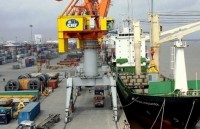
Vietnam’s pepper industry bears ‘price shock’
Latest
| TIN LIÊN QUAN | |
| Pepper exports see strongest growth in India | |
| Binh Phuoc targets sustainable pepper supply chain | |
According to the General Department of Customs (GDC), in 2017 Vietnam exported 215,000 tons of pepper worth 1.2 billion USD, a 20 percent increase in quantity compared with the same period last year, but a 22.2 percent decrease in value.
Nguyen Nam Hai, chair of the Vietnam Pepper Association (VPA), said the total pepper output in the world in 2017 was 40,000 tons higher than 2016, while the output in 2018 is expected to be 80,000 tons higher.
The continued pepper price increase in the last 10 years led to Vietnamese farmers expanding the pepper growing area.
By 2017, the total pepper area had reached 152,000 hectares and the output was VND240,000 tons, amounting to 48 percent of the total output of the world.
 |
| Vietnam exported 215,000 tons of pepper in 2017. (Photo: Vietnamnet) |
This contributed to a global price decrease. In 2017, the pepper price fell from 11.33 USD per kilogram to 4.78 USD.
According to the Ba Ria – Vung Tau Pepper Association, the current pepper growing area in the province is 13,000 hectares, far exceeding the area of 8,500 hectares the local authorities planned for 2030.
The same situation is occurring in many pepper growing provinces.
Willem Van Walt Meijer, managing director of Nedspice Vietnam, confirmed that exports now had not gone smoothly as seen in the past. The big stocks have forced the prices down, thus shrinking the profits of pepper exporters.
| In 2017 Vietnam exported 215,000 tons of pepper worth 1.2 billion USD, a 20 percent increase in quantity compared with the same period last year, but a 22.2 percent decrease in value. |
India, one of Vietnam’s major export markets, has restricted imports to protect the domestic pepper industry. The Indian government has high taxes on imports. Meanwhile, the US and some European countries have set up technical barriers against Vietnam’s pepper.
Vietnam now has to compete fiercely with emerging rivals. Brazil, for example, produces high-quality pepper which nearly meets the standards of organic pepper.
Cambodia, which is e landing pepper farming, is predicted to become the third or fourth largest pepper exporter in the next few years.
An analyst said it is unpredictable when the pepper price recovers. The export volume globally has increased by 20 percent per annum, while the world’s demand increased by 5 percent only, which means that big stocks cannot be cleared within a short time.
According to Hai, to ensure the sustainable development of the pepper industry, it is necessary to restructure the growing area.
He suggested that exporters join forces with farmers to generate clean material areas, saying that if Vietnam doesn’t have high-quality pepper, its products will be uncompetitive with products from Brazil, Malaysia and Indonesia.
 | VN earns 33.62 billion USD from exports in two months Vietnam’s total export value was estimated at 33.62 billion USD by the end of February, a year-on-year increase of 22.9 percent, revealed the General Department ... |
 | Middle East emerges as new destination for Vietnam’s exports Vietnamese businesses’ expansion to the Middle East market is considered an important and long-term strategic direction amidst saturated traditional markets and decreased consumption. |
 | Ample opportunity for Vietnam’s exports to EU market The EU is now the country’s second largest export market taking key commodities such as seafood, garments and textiles, footwear, and wood and wooden products. |
























